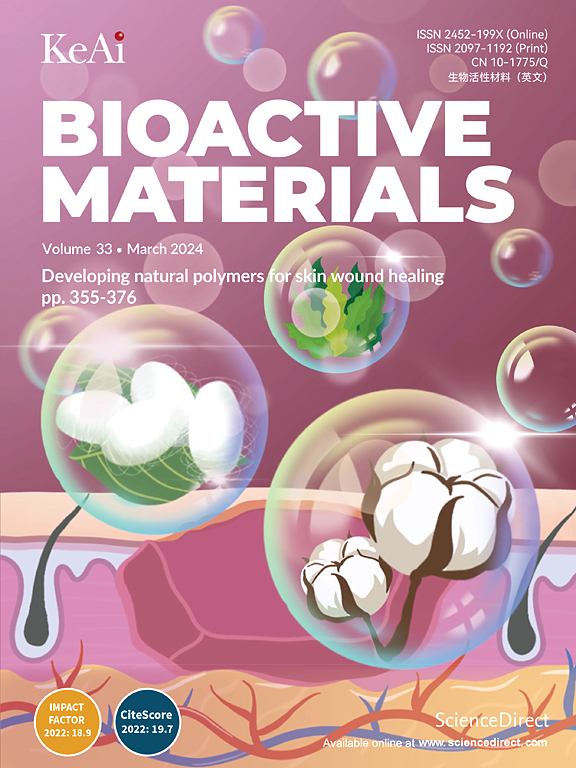3D-printed PCL scaffolds combined with injectable sodium alginate/magnesium-doped mesoporous bioactive glass nanosphere hydrogel for meniscus regeneration: In vitro, In vivo, and multiomics-based therapeutic analyses
IF 18
1区 医学
Q1 ENGINEERING, BIOMEDICAL
引用次数: 0
Abstract
Meniscal injury presents a formidable challenge and often leads to functional impairment and osteoarthritic progression. Meniscus tissue engineering (MTE) is a promising solution, as conventional strategies for modulating local immune responses and generating a conducive microenvironment for effective tissue repair are lacking. Recently, magnesium-containing bioactive glass nanospheres (Mg-BGNs) have shown promise in tissue regeneration. However, few studies have explored the ability of Mg-BGNs to promote meniscal regeneration. First, we verified the anti-inflammatory and fibrochondrogenic abilities of Mg-BGNs in vitro. A comprehensive in vivo evaluation of a rabbit critical-size meniscectomy model revealed that Mg-BGNs have multiple effects on meniscal reconstruction and effectively promote fibrochondrogenesis, collagen deposition, and cartilage protection. Multiomics analysis was subsequently performed to further explore the mechanism by which Mg-BGNs regulate the regenerative microenvironment. Mechanistically, Mg-BGNs first activate the TRPM7 ion channel through the PI3K/AKT signaling pathway to promote the cellular function of synovium-derived mesenchymal stem cells and then activate the PPARγ/NF-κB axis to modulate macrophage polarization and inflammatory reactions. We demonstrated that Mg2+ is critical for the crosstalk among biomaterials, immune cells, and effector cells in Mg-BGN-mediated tissue regeneration. This study provides a theoretical basis for the application of Mg-BGNs as nanomedicines to achieve in situ tissue regeneration in complex intrajoint pathological microenvironments.

3d打印PCL支架与可注射海藻酸钠/镁掺杂介孔生物活性玻璃纳米球水凝胶联合用于半月板再生:体外,体内和基于多组学的治疗分析
半月板损伤是一个巨大的挑战,经常导致功能损伤和骨关节炎的进展。由于缺乏调节局部免疫反应和产生有利于有效组织修复的微环境的传统策略,半月板组织工程(MTE)是一个很有前途的解决方案。最近,含镁生物活性玻璃纳米球(Mg-BGNs)在组织再生中显示出前景。然而,很少有研究探讨Mg-BGNs促进半月板再生的能力。首先,我们在体外验证了mg - bgn的抗炎和成纤维软骨能力。兔半月板切除模型的体内综合评价显示,Mg-BGNs对半月板重建具有多重作用,可有效促进纤维软骨形成、胶原沉积和软骨保护。随后进行多组学分析以进一步探索mg - bgn调节再生微环境的机制。在机制上,mg - bgn首先通过PI3K/AKT信号通路激活TRPM7离子通道,促进滑膜源间充质干细胞的细胞功能,然后激活PPARγ/NF-κB轴,调节巨噬细胞极化和炎症反应。我们证明,在mg - bgn介导的组织再生中,Mg2+对生物材料、免疫细胞和效应细胞之间的串扰至关重要。本研究为Mg-BGNs作为纳米药物在复杂关节内病理微环境中实现组织原位再生提供了理论基础。
本文章由计算机程序翻译,如有差异,请以英文原文为准。
求助全文
约1分钟内获得全文
求助全文
来源期刊

Bioactive Materials
Biochemistry, Genetics and Molecular Biology-Biotechnology
CiteScore
28.00
自引率
6.30%
发文量
436
审稿时长
20 days
期刊介绍:
Bioactive Materials is a peer-reviewed research publication that focuses on advancements in bioactive materials. The journal accepts research papers, reviews, and rapid communications in the field of next-generation biomaterials that interact with cells, tissues, and organs in various living organisms.
The primary goal of Bioactive Materials is to promote the science and engineering of biomaterials that exhibit adaptiveness to the biological environment. These materials are specifically designed to stimulate or direct appropriate cell and tissue responses or regulate interactions with microorganisms.
The journal covers a wide range of bioactive materials, including those that are engineered or designed in terms of their physical form (e.g. particulate, fiber), topology (e.g. porosity, surface roughness), or dimensions (ranging from macro to nano-scales). Contributions are sought from the following categories of bioactive materials:
Bioactive metals and alloys
Bioactive inorganics: ceramics, glasses, and carbon-based materials
Bioactive polymers and gels
Bioactive materials derived from natural sources
Bioactive composites
These materials find applications in human and veterinary medicine, such as implants, tissue engineering scaffolds, cell/drug/gene carriers, as well as imaging and sensing devices.
 求助内容:
求助内容: 应助结果提醒方式:
应助结果提醒方式:


